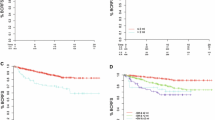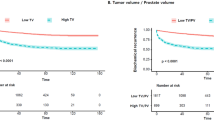Abstract
Purpose
This study was designed to assess the independent prognostic value of tumor volume (TV) and whether adding TV provides additional prognostic information for predicting biochemical recurrence (BCR) after radical prostatectomy.
Methods
We reviewed the medical records of 1,129 patients who underwent radical prostatectomy between July 2005 and July 2011. TV was categorized as minimal (≤1.0 ml), moderate (1.1–5.0 ml), or extensive (>5.0 ml). Cox regression analysis was performed to identify independent predictors of BCR. The predictive accuracies of Cox’s proportional hazard regression models with and without TV were quantified and compared using time-dependent receiver operating characteristic curve analysis.
Results
Increasing TV was associated with higher prostate specific antigen, pathological Gleason score, and pathologic tumor stage. TV was an independent predictor of BCR in multivariate analysis (p < 0.001). When patients were stratified by organ-confined and nonorgan-confined tumor groups, TV remained an independent predictor of BCR in organ-confined tumors (p < 0.001). In the nonorgan-confined tumor group, a significant difference was found only between extensive versus minimal TV (p = 0.023). The predictive accuracy of the Cox regression model increased significantly by adding TV in organ-confined tumor group (0.748 vs. 0.704, p < 0.05) but not in nonorgan-confined group (0.742 vs. 0.734, p > 0.05).
Conclusions
TV was an independent prognostic predictor of BCR in organ-confined prostate cancers and provided additional prognostic information with increased predictive accuracy. In contrast, TV did not increase the predictive accuracy in nonorgan-confined tumor. TV should be considered as a prognosticator in organ-confined tumors.

Similar content being viewed by others
References
Stamey TA, McNeal JE, Yemoto CM, Sigal BM, Johnstone IM. Biological determinants of cancer progression in men with prostate cancer. JAMA. 1999;281:1395–400.
Vollmer RT. Percentage of tumor in prostatectomy specimens: a study of American Veterans. Am J Clin Pathol. 2009;131:86–91.
Ramos CG, Roehl KA, Antenor JA, Humphrey PA, Catalona WJ. Percent carcinoma in prostatectomy specimen is associated with risk of recurrence after radical prostatectomy in patients with pathologically organ confined prostate cancer. J Urol. 2004;172:137–40.
Eichelberger LE, Koch MO, Eble JN, Ulbright TM, Juliar BE, Cheng L. Maximum tumor diameter is an independent predictor of prostate-specific antigen recurrence in prostate cancer. Mod Pathol. 2005;18:886–90.
Marks RA, Lin H, Koch MO, Cheng L. Positive-block ratio in radical prostatectomy specimens is an independent predictor of prostate-specific antigen recurrence. Am J Surg Pathol. 2007;31:877–81.
Chun FK, Briganti A, Jeldres C, et al. Tumour volume and high grade tumour volume are the best predictors of pathologic stage and biochemical recurrence after radical prostatectomy. Eur J Cancer. 2007;43:536–43.
Salomon L, Levrel O, Anastasiadis AG, et al. Prognostic significance of tumor volume after radical prostatectomy: a multivariate analysis of pathological prognostic factors. Eur Urol. 2003;43:39–44.
Porten SP, Cooperberg MR, Carroll PR. The independent value of tumour volume in a contemporary cohort of men treated with radical prostatectomy for clinically localized disease. BJU Int. 2010;105:472–5.
Wolters T, Roobol MJ, van Leeuwen PJ, et al. Should pathologists routinely report prostate tumour volume? The prognostic value of tumour volume in prostate cancer. Eur Urol. 2010;57:821–9.
Kikuchi E, Scardino PT, Wheeler TM, Slawin KM, Ohori M. Is tumor volume an independent prognostic factor in clinically localized prostate cancer? J Urol. 2004;172:508–11.
van Oort IM, Witjes JA, Kok DE, Kiemeney LA, Hulsbergen vandeKaa CA. Maximum tumor diameter is not an independent prognostic factor in high-risk localized prostate cancer. World J Urol. 2008;26:237–41.
Epstein JI. Prognostic significance of tumor volume in radical prostatectomy and needle biopsy specimens. J Urol. 2011;186:790–7.
Renshaw AA, Chang H, D’Amico AV. Estimation of tumor volume in radical prostatectomy specimens in routine clinical practice. Am J Clin Pathol. 1997;107:704–8.
Heagerty PJ, Zheng Y. Survival model predictive accuracy and ROC curves. Biometrics. 2005;61:92–105.
Hyun SH, Choi JY, Shim YM, et al. Prognostic value of metabolic tumor volume measured by 18F-fluorodeoxyglucose positron emission tomography in patients with esophageal carcinoma. Ann Surg Oncol. 2010;17:115–22.
Nelson BA, Shappell SB, Chang S, Wells N, Farnham SB, Smith JA, Cookson MS. Tumour volume is an independent predictor of prostate-specific antigen recurrence in patients undergoing radical prostatectomy for clinically localized prostate cancer. BJU Int. 2006;97:1169–72.
Uhlman MA, Sun L, Stackhouse DA, et al. Tumor percent involvement predicts prostate specific antigen recurrence after radical prostatectomy only in men with smaller prostate. J Urol. 2010;183:997–1001.
Epstein JI, Carmichael M, Partin AW, Walsh PC. Is tumor volume an independent predictor of progression following radical prostatectomy? A multivariate analysis of 185 clinical stage B adenocarcinomas of the prostate with 5 years of followup. J Urol. 1993;149:1478–81.
Noguchi M, Stamey TA, McNeal JE, Yemoto CE. Assessment of morphometric measurements of prostate carcinoma volume. Cancer. 2000;89:1056–64.
van der Kwast TH, Amin MB, Billis A, et al. International Society of Urological Pathology (ISUP) Consensus Conference on Handling and Staging of Radical Prostatectomy Specimens. Working group 2: T2 substaging and prostate cancer volume. Mod Pathol. 2011;24:16–25.
Chen ME, Johnston D, Reyes AO, Soto CP, Babaian RJ, Troncoso P. A streamlined three-dimensional volume estimation method accurately classifies prostate tumors by volume. Am J Surg Pathol. 2003;27:1291–301.
Humphrey PA, Vollmer RT. Intraglandular tumor extent and prognosis in prostatic carcinoma: application of a grid method to prostatectomy specimens. Hum Pathol. 1990;21:799–804.
Cheng WS, Frydenberg M, Bergstralh EJ, Larson Keller JJ, Zincke H. Radical prostatectomy for pathologic stage C prostate cancer: influence of pathologic variables and adjuvant treatment on disease outcome. Urology. 1993;42:283–91.
Song C, Ro JY, Lee M, et al. Prostate cancer in Korean men exhibits poor differentiation and is adversely related to prognosis after radical prostatectomy. Urology. 2006;68:820–4.
Merrill M, Lane BR, Reuther AM, Zhou M, Magi Galluzzi C, Klein EA. Tumor volume does not predict for biochemical recurrence after radical prostatectomy in patients with surgical Gleason score 6 or less prostate cancer. Urology. 2007;70:294–8.
Hashimoto K, Masumori N, Takei F, et al. Prognostic value of surgical margin status for biochemical recurrence following radical prostatectomy. Jpn J Clin Oncol. 2008;38:31–5.
Jeong CW, Jeong SJ, Hong SK, et al. Nomograms to predict the pathological stage of clinically localized prostate cancer in Korean men: comparison with western predictive tools using decision curve analysis. Int J Urol. 2012;19:846–52.
Song C, Seo S, Ahn H, et al. Percent tumor volume predicts biochemical recurrence after radical prostatectomy: multi-institutional data analysis. Int J Clin Oncol. 2012;17:355–60.
Marchetti PE, Shikanov S, Razmaria A, Zagaja GP, Shalhav AL. Impact of prostate weight on probability of positive surgical margins in patients with low-risk prostate cancer after robotic-assisted laparoscopic radical prostatectomy. Urology. 2011;77:677–81.
Sherwin JC, Mirmilstein G, Pedersen J, Lawrentschuk N, Bolton D, Mills J. Tumor volume in radical prostatectomy specimens assessed by digital image analysis software correlates with other prognostic factors. J Urol. 2010;183:1808–14.
Cheng L, Koch MO, Juliar BE, Daggy JK, Foster RS, Bihrle R, et al. The combined percentage of Gleason patterns 4 and 5 is the best predictor of cancer progression after radical prostatectomy. J Clin Oncol. 2005;23:2911–7.
Palisaar RJ, Graefen M, Karakiewicz PI, et al. Assessment of clinical and pathologic characteristics predisposing to disease recurrence following radical prostatectomy in men with pathologically organ-confined prostate cancer. Eur Urol. 2002;41:155–61.
Acknowledgment
The Research Foundation of Korea (NRF) grant funded by the Korea government (MEST) (2011-0029348) supported this work.
Conflict of interest
No author has any conflict of interest.
Author information
Authors and Affiliations
Corresponding author
Rights and permissions
About this article
Cite this article
Kim, K.H., Lim, S.K., Shin, TY. et al. Tumor Volume Adds Prognostic Value in Patients with Organ-Confined Prostate Cancer. Ann Surg Oncol 20, 3133–3139 (2013). https://doi.org/10.1245/s10434-013-3016-4
Received:
Published:
Issue Date:
DOI: https://doi.org/10.1245/s10434-013-3016-4




